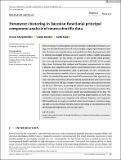Files in this item
Parameter clustering in Bayesian functional principal component analysis of neuroscientific data
Item metadata
| dc.contributor.author | Margaritella, Nicolò | |
| dc.contributor.author | Inácio, Vanda | |
| dc.contributor.author | King, Ruth | |
| dc.date.accessioned | 2022-03-15T10:30:09Z | |
| dc.date.available | 2022-03-15T10:30:09Z | |
| dc.date.issued | 2021-01-15 | |
| dc.identifier.citation | Margaritella , N , Inácio , V & King , R 2021 , ' Parameter clustering in Bayesian functional principal component analysis of neuroscientific data ' , Statistics in Medicine , vol. 40 , no. 1 , pp. 167-184 . https://doi.org/10.1002/sim.8768 | en |
| dc.identifier.issn | 0277-6715 | |
| dc.identifier.other | PURE: 278278340 | |
| dc.identifier.other | PURE UUID: 251b63d4-0e8b-42bb-8adb-a55b640247eb | |
| dc.identifier.other | PubMed: 33040367 | |
| dc.identifier.other | Scopus: 85092377370 | |
| dc.identifier.uri | https://hdl.handle.net/10023/25048 | |
| dc.description.abstract | The extraordinary advancements in neuroscientific technology for brain recordings over the last decades have led to increasingly complex spatiotemporal data sets. To reduce oversimplifications, new models have been developed to be able to identify meaningful patterns and new insights within a highly demanding data environment. To this extent, we propose a new model called parameter clustering functional principal component analysis (PCl-fPCA) that merges ideas from functional data analysis and Bayesian nonparametrics to obtain a flexible and computationally feasible signal reconstruction and exploration of spatiotemporal neuroscientific data. In particular, we use a Dirichlet process Gaussian mixture model to cluster functional principal component scores within the standard Bayesian functional PCA framework. This approach captures the spatial dependence structure among smoothed time series (curves) and its interaction with the time domain without imposing a prior spatial structure on the data. Moreover, by moving the mixture from data to functional principal component scores, we obtain a more general clustering procedure, thus allowing a higher level of intricate insight and understanding of the data. We present results from a simulation study showing improvements in curve and correlation reconstruction compared with different Bayesian and frequentist fPCA models and we apply our method to functional magnetic resonance imaging and electroencephalogram data analyses providing a rich exploration of the spatiotemporal dependence in brain time series. | |
| dc.format.extent | 18 | |
| dc.language.iso | eng | |
| dc.relation.ispartof | Statistics in Medicine | en |
| dc.rights | Copyright © 2020 The Authors. Statistics in Medicine published by John Wiley & Sons Ltd. This is an open access article under the terms of the Creative Commons Attribution License, which permits use, distribution and reproduction in any medium, provided the original work is properly cited. | en |
| dc.subject | Bayes Theorem | en |
| dc.subject | Cluster Analysis | en |
| dc.subject | Computer Simulation | en |
| dc.subject | Humans | en |
| dc.subject | Magnetic Resonance Imaging | en |
| dc.subject | Principal Component Analysis | en |
| dc.subject | Dirichlet process | en |
| dc.subject | Functional data analysis | en |
| dc.subject | Neuroscience | en |
| dc.subject | Spatiotemporal data | en |
| dc.subject | HA Statistics | en |
| dc.subject | RC0321 Neuroscience. Biological psychiatry. Neuropsychiatry | en |
| dc.subject | NDAS | en |
| dc.subject | MCC | en |
| dc.subject.lcc | HA | en |
| dc.subject.lcc | RC0321 | en |
| dc.title | Parameter clustering in Bayesian functional principal component analysis of neuroscientific data | en |
| dc.type | Journal article | en |
| dc.description.version | Publisher PDF | en |
| dc.contributor.institution | University of St Andrews. Statistics | en |
| dc.identifier.doi | https://doi.org/10.1002/sim.8768 | |
| dc.description.status | Peer reviewed | en |
This item appears in the following Collection(s)
Items in the St Andrews Research Repository are protected by copyright, with all rights reserved, unless otherwise indicated.

